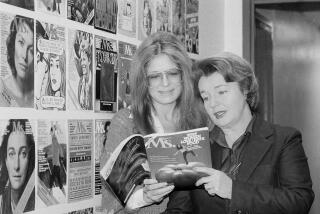Book Review : A View of the U.S. Female Melting Pot
- Share via
Imaging American Women: Idea and Ideals in Cultural History by Martha Banta (Columbia University Press: $50; 844 pages, illustrated)
At first glance, Martha Banta’s “Imaging American Women” appears to offer an encyclopedia contribution to the iconography of gender. The book, nearly 900 pages in length, contains hundreds of illustrations, reproductions of painting, sculpture, drawings, photographs, cartoons, poster art and advertisements. The images are taken from the period 1876 to 1918, a time when a new American consumer culture was taking shape, and with it a previously unimaginable proliferation of mass-produced images. Vachel Lindsay called all of this a new “hieroglyphic civilization.”
Banta sets out to decipher the ubiquitous female images within this newly emerged world of visual codes. Her basic argument is that people are formed as “social beings” in the process of interpreting the various symbols that surround them. In the case of late 19th- Century America, Banta contends, images of women provided an opportunity for Americans to express their “collective will.”
Images of women, she argues, were the texts by which people learned what it meant to be an American. Thus, “The American Girl,” “The Outdoor Girl,” “The Beautiful Charmer,” “The New England Girl” and “The New Woman,” the author maintains, combined to express a particularly American sensibility.
Prove a Synchronicity
Juxtaposing homemade photographs of her mother (and her mother’s friends) with turn-of-the-century commercial and “high art” iconography, the author tries to prove a synchronicity between late-19th-Century artistic conventions and the aspirations of everyday Americans as seen in the literature of the 19th-Century genteel tradition (especially Henry James). Her elucidation of an American consensus depends, however, on her ability to erase all experiences that don’t conform to her typology. Similarly, she eliminates any examination of the tensions between vernacular and high culture, tensions that are particularly important during this period. Though awareness that the icons she cites are specific to a white native-born middle-class genteel culture, Banta nonetheless believes that they can be made to speak for everyone. Class, race and ethnic differences exist, to be sure, but for Banta, images of women provided a perceptual melting pot where elite and popular culture mixed.
Banta passionately defends genteel images of women in repose, women gazing vacantly into the void--a common image of the period. Mocking feminist claims, she argues that “strong images of women” do not necessarily come from images of women engaged in activity. Instead, Banta locates feminine strength in the languid eyes of women who “think, dream and rest.” Arguing against the 19th-Century feminist critique of socially imposed passivity and confinement, she goes on to say that “portraits of women who live for the time being in their mind or unconscious may in fact be portraits of women doing useful work.” Useful work, ironically, was one of the major demands of 19th-Century women locked into the conventions of gentility.
Reveries Become Action
During that period, millions of women joined clubs and settlement houses, temperance and suffrage organizations. And they were inspired by the growing numbers of working women; by 1900, 6 million women were gainfully employed. Out of necessity, many of these women turned their private reveries into public action. For them, genteel portraits eulogized confinement, a world to flee, not embrace. Only through a strong combination of thought and action could women break into that larger world, one that still denied them the rights of citizenship, useful work and public thought.
Rather than appreciating the rejection of gentility as part of a crisis of late-19th-Century middle-class life, Banta dismisses such tendencies as shrill and without substance. Although she is eager to hold up the thoughts of gentility and privilege in her iconographic examination and gives them a featured voice in her discourse, she does not do the same for women whose voices would have provided some sense of the contradictions and conflicts of the period. In choosing this topic, Banta reveals the influence of feminism on her own scholarly pursuits, yet in her flippant disavowal of a feminist perspective she deprives herself of a vantage point from which she might have begun to make sense of her subject.
More to Read
The biggest entertainment stories
Get our big stories about Hollywood, film, television, music, arts, culture and more right in your inbox as soon as they publish.
You may occasionally receive promotional content from the Los Angeles Times.










